Rainy Season in Mexico: All You Need to Know + Travel Tips
Are you planning to travel during the rainy season in Mexico and worried about the weather forecast?
I’ve traveled and lived in Mexico for more than five years. And I’m about to tell you everything you need to know about the Mexico rainy season.
Spoiler alert. The rain in Mexico typically doesn’t last for days like a quick look at the weather report makes it seem.
Continue reading about the wet season in Mexico so that you can be more prepared for your travels to this vast and beautiful country.
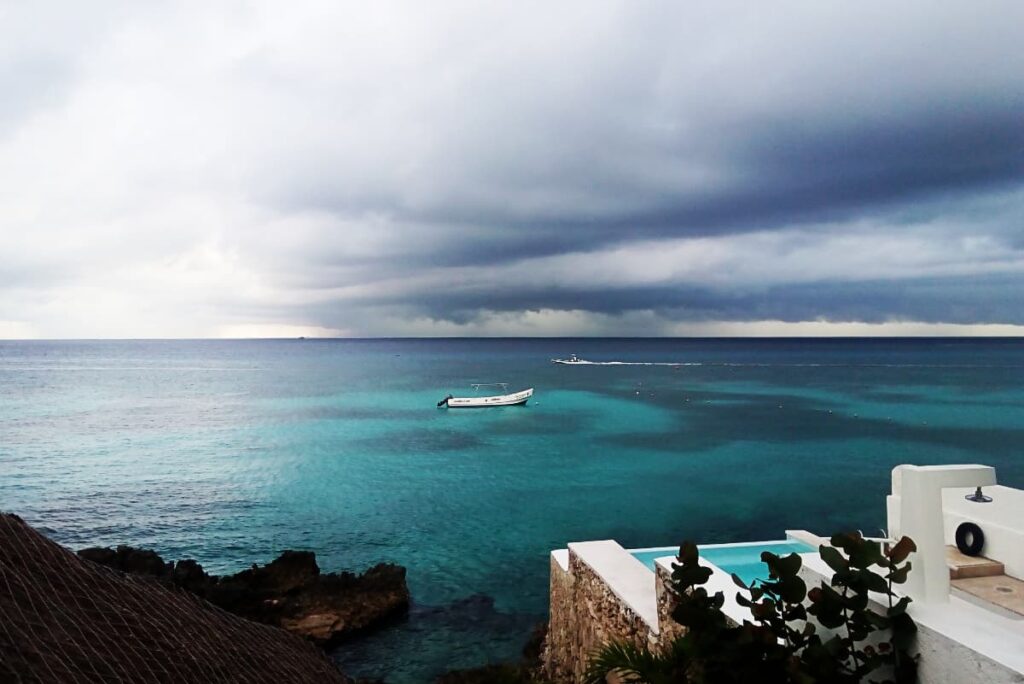
When is the Rainy Season in Mexico?
The rainy season in Mexico generally begins in May or June and lasts through October or November. You should expect rainfall throughout most of Mexico during this period.
However, the rain typically arrives in the late afternoon and is short-lived. And it is often a welcome relief from the elevated temperatures.
Pros of Traveling During Mexico Rainy Season
- Lower Prices – During Mexico’s rainy season, you’ll likely find lower prices for accommodations and attractions due to fewer tourists.
- Less Crowded – Since there are fewer tourists during the rainy season in Mexico, you can enjoy a more tranquil atmosphere at popular destinations.
- Lush Scenery – Rain in Mexico brings life to its landscapes, often making them incredibly lush and vibrant during this time.
- Beautiful Skies – Rainstorms also often bring incredible cloud formations that create beautiful skies and sometimes rainbows.
Cons of Traveling During Mexico Rainy Season
- Rain and Storms – You’ll need to be more aware of the potential for unexpected storms and rain in Mexico during this time. Make sure to pack a raincoat and/or umbrella.
- Limited Activities – Although many outdoor activities can still be enjoyed, some might be restricted or impacted by the weather. For example, some of the waterfalls in Huasteca Potosina become very full during Mexico’s rainy season.
- Hurricanes – The rainy season in Mexico overlaps with the hurricane season. Although this mostly affects coastal areas such as Cancun and the Riviera Maya, it’s possible that remnants of a hurricane will travel into the central parts of the country and result in prolonged rain in Mexico.
- Heat and Humidity – As expected, humidity levels tend to rise during Mexico’s rainy season, which might make the heat feel more intense. If you’re outdoors and sweating, you’ll want to drink plenty of water to stay hydrated.

As you plan your trip to Mexico during the rainy season, consider the pros and cons mentioned above. Whether traveling during the wet season in Mexico is right for you will depend on your destination and what you plan to do during your trip.
Duration and Intensity of Rain in Mexico
Over and over again, I see travelers ask about the forecasted rain in Mexico just before their planned trip.
They are rightfully concerned because it looks like rain every day and they are wondering how that will dampen their travels.
The truth is, the wet season in Mexico can bring daily showers. But they are often only for a short time in the afternoon.
The mornings in many parts of Mexico are typically sunny and dry, allowing you to make the most of your day. And when the afternoon rain storms do roll in, it’s often a welcome relief from the heat of the day.
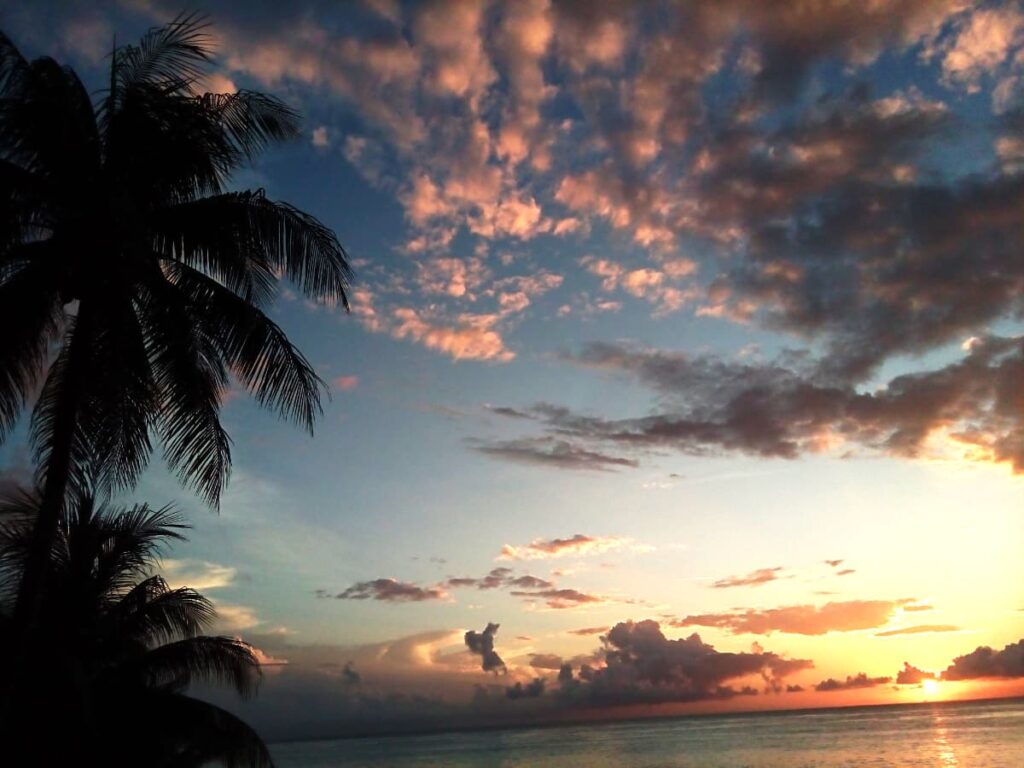
Does Rain in Mexico Last All Day?
The rain in Mexico does not typically last all day. It often comes in short bursts, usually in the late afternoon or evening. Sometimes Mexico’s rainy season brings heavy showers that create a cooler and more comfortable atmosphere after they pass.
The rain in Mexico can increase the humidity in some areas, especially near the coast and the Yucatan Peninsula.
It’s also worth noting that the frequency of hurricanes increases during the rainy season. While these typically affect the coastline, remnants can continue into central Mexico, bringing lengthened rains.
Traveling During the Rainy Season in Mexico
While Mexico’s rainy season does bring increased precipitation in most areas, it can be a great time to travel. Let’s look at the best time to visit Mexico as well as a few rainy season activities.
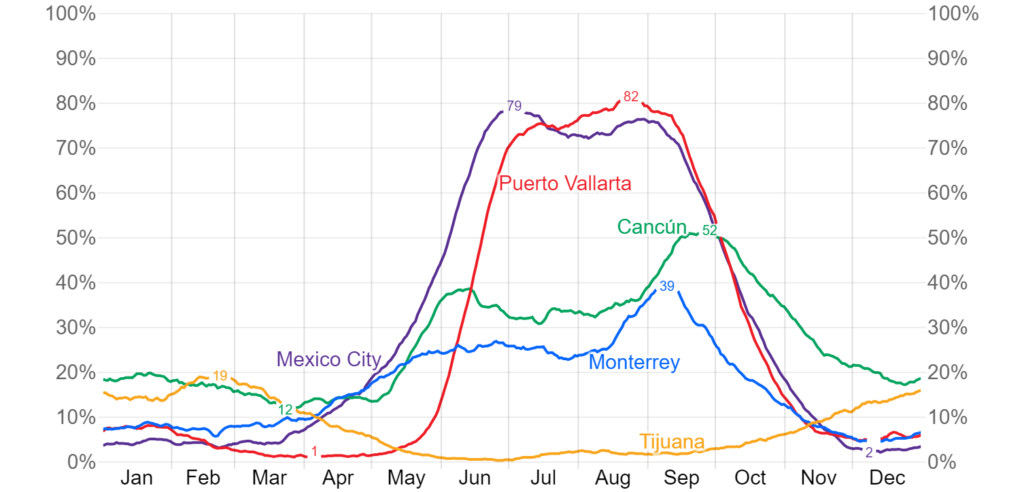
Best Time to Visit Mexico
For most people, the best time to visit Mexico is November through March. However, the best time to travel to Mexico for you will depend on where you are traveling and your priorities.
As I’ve discussed, there are advantages to traveling during the rainy season in Mexico, such as lower prices and fewer people. So, if you don’t mind elevated temperatures and afternoon rainstorms, traveling to Mexico during the rainy season could be the best time to visit for you.
That said, every region has its particularities. For instance, the rainy season in Mexico City, Cancun, Baja, and Oaxaca differ, so it’s best to research your desired destination ahead of time.
Mexico Rainy Season Activities
While the rainy season might not seem like the ideal time for a vacation for some, you can still enjoy many unique experiences in Mexico during this time. This is especially true if you start your adventures early in the morning, and take a siesta in the afternoons.

- Cenotes: While I find cenotes to be refreshing throughout the year, the summer months are perfect for dipping into these underground water formations, especially after a visit to one of the many Mayan Ruins in the Yucatan.
- Museums: As in most destinations, museums are a great place to explore during the wet season in Mexico. During my travels, the museums in Merida Yucatan have provided both relief from the sun and shelter from the rain.
- Cuisine: I find that restaurants can also provide a great hideaway while traveling during the rainy season. Whether you seek out the traditional foods of Mexico or more international cuisine, this can be a great rainy day activity with friends.
Preparing for Mexico’s Rainy Season
Tips For the Wet Season in Mexico
To make the most of your visit during the rainy season in Mexico, consider some of the following tips to be able to enjoy the beauty this country has to offer.
- Check the Hourly Forecast: When you’re forecasting rain in a tropical region, it’s best to check the hourly forecast. A quick look at the weather report often makes it seem like it will rain all week. When you’re able to take a more detailed view, you can be better prepared.
- Be Prepared for the Rain: Pack a quality raincoat, waterproof shoes, and an umbrella to stay dry and comfortable. You should always bring these with you while exploring during the wet season in Mexico.
- Explore in the Early Morning: Mornings usually have less rain in Mexico compared to afternoons and evenings. So it’s best to explore early and take an afternoon siesta during the heat of the day.
- Research Indoor Attractions: Use rainy days as an opportunity to explore museums, art galleries, and other indoor sites at your destination. Keep a list handy in case of an unexpected storm.
Safety Precautions For Rain in Mexico
Keep these safety precautions in mind if you’re visiting Mexico during the rainy season.
- Monitor Weather Updates: Stay informed about potential heavy rain or storms to plan your activities accordingly and adjust your plans if needed.
- Avoid Swimming During Storms: Strong currents and bigger waves make it dangerous to swim or participate in water sports during heavy rain or storms.
- Avoid Flooded Areas: Flash floods can be common during the rainy season in Mexico, especially in mountainous areas. You should avoid walking or driving through flooded areas, as water levels can rise rapidly.
- Prepare for Potential Power Outages: I travel with a portable charger whether it’s the rainy season or not. During the rainy season, it is more important to keep it charged in case of a power outage. You can also ask your accommodation about a flashlight if you are in an area prone to outages during a storm.
Regions of Mexico: Rainy Season Characteristics
I’ve created a general guide to Mexico’s rainy season for different areas of the country. However, you should consider that there are microclimates within these regions that may have more of an impact than these general weather guidelines.
Yucatan Peninsula
The Yucatan Peninsula and the Riviera Maya, which includes popular destinations like Cancun, experience a rainy season that usually spans from May through November.
This region is one of the most humid places in Mexico. I lived in this area of Mexico for more than two years and the heat and humidity can be stifling.
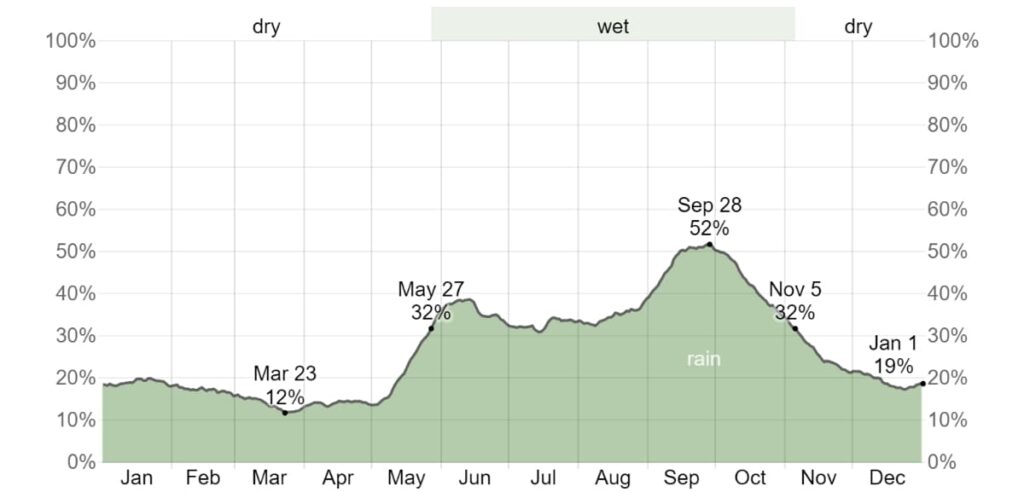
You will find some relief if you are staying in an area with coastal breezes, but in general, it’s incredibly hot and humid during the rainy season.
You should also be aware that the Yucatan and the Riviera Maya also have a high risk of hurricanes and tropical storms during the rainy season in Mexico. If you’re visiting during this time, it is essential to keep up to date with the weather.
Despite the heat and humidity, the coastline along the Caribbean coast and the Mayan Riviera remain some of the most popular beach destinations in Mexico.
Central Mexico
In Central Mexico, including Mexico City, the rainy season follows a similar pattern, generally occurring from June through October.
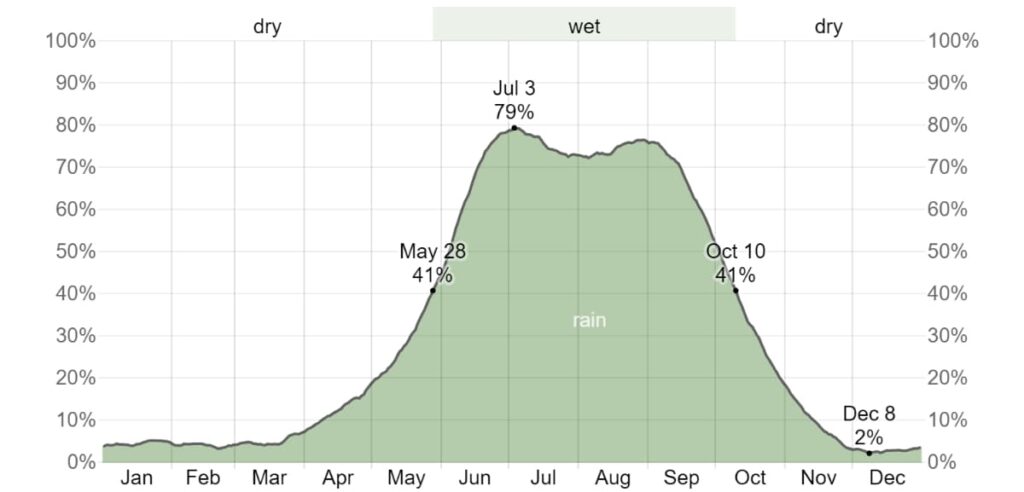
This elevation of this region tends to keep humidity at bay and temperatures cooler. Although during the rainy season in Mexico City, I have experienced unexpected downpours that lasted several hours.
My advice is to keep a small umbrella or rain gear with you when you go out, especially in the afternoon and evening.
Southern Mexico
In Southern Mexico, the rainy season typically brings higher humidity levels than in the other regions. The benefits of the increased rain and humidity are the lush landscapes in Southern Mexico during the wet season.
And depending on the elevation, temperatures may drop by 30 degrees Fahrenheit or more at night, providing a refreshing relief that lasts through the early mornings.
Northern Mexico
In Northern Mexico, the rainy season generally lasts from June through October.
While many areas of Northern Mexico are not as humid as other regions, storms can still develop during this time, especially in mountainous areas.
Although it is believed that the Sierra Madre mountain range helps to develop the North American monsoons in June, the climate during the rainy season in northern Mexico varies.
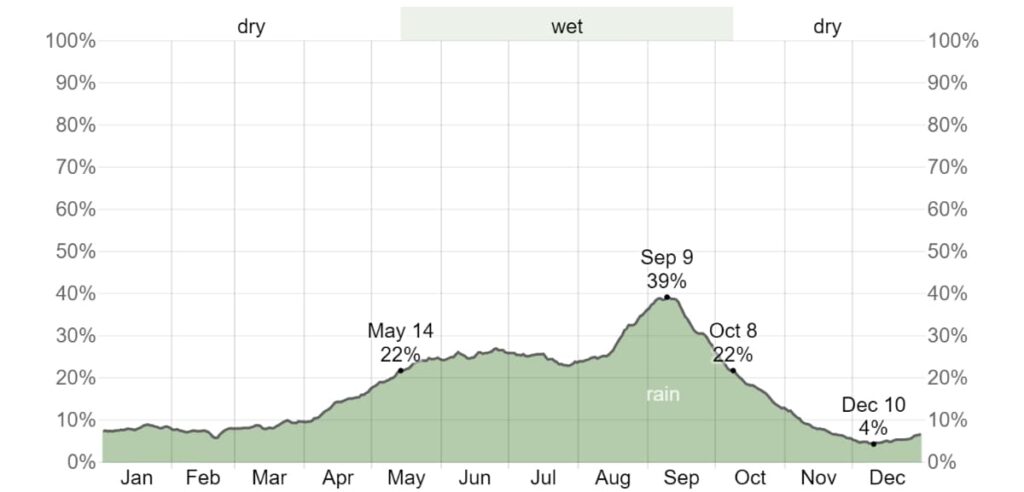
The modern city of Monterrey in Northeast Mexico for instance receives more precipitation throughout the year and tends to be quite humid during the rainy season.
On the other hand, Ciudad Juarez in the northwest tends to receive less rain and humidity even during the rainy season. The Baja Peninsula differs even more (see next).
Pacific Coast of Mexico
Similar to other coastal areas in Mexico, the Pacific Coast is characterized as hot and humid during the rainy season.
Although rainfall along the Pacific coast of Mexico is generally more concentrated into a few summer months, peaking in September.

During this time, it’s common for these areas to receive 9 inches or more of rain in a single month! This is especially true in Puerto Vallarta and Mazatlan, along the northern Pacific coast.
Baja Peninsula
The rainy season in the Baja Peninsula differs from the rest of Mexico, mainly due to its drier climate.
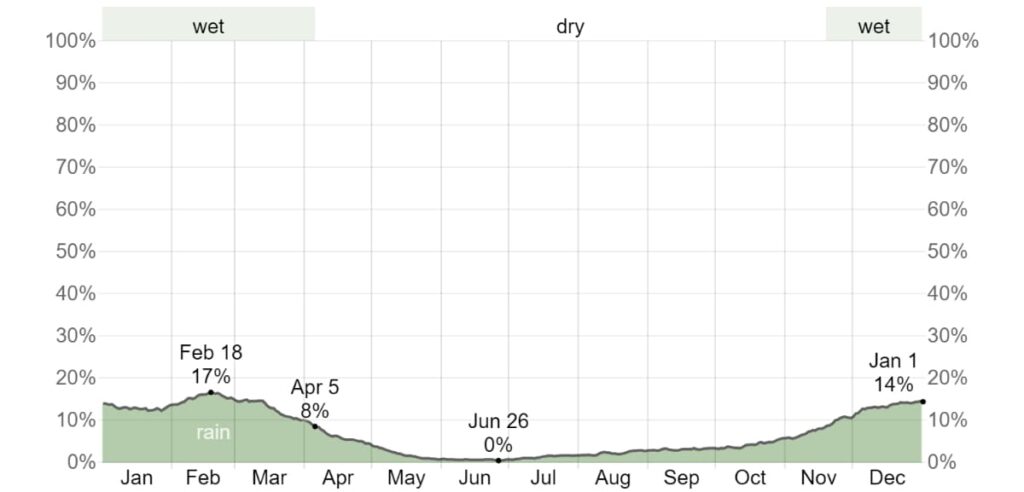
The rainy season in Tijuana, Rosarito, Ensenada, and other parts of the northern Baja Peninsula lasts from roughly November through mid-April. This part of the Baja Peninsula receives virtually no rain from May through October.
As you travel further south in the Baja Peninsula to coastal destinations such as Cabo San Lucas, the wet season follows a similar pattern to other parts of Mexico, although with less total rain.
While there tends to be less annual rainfall throughout the Baja Peninsula, you should still be prepared for occasional storms, especially in coastal areas of the southern peninsula.
Final Thoughts on Mexico Rainy Season
You can have an enjoyable time exploring Mexico during the rainy season and experience the lush vegetation that comes with the rain in Mexico.
As we’ve discovered, traveling during the rainy season in Mexico typically means fewer tourists and lower prices. However, you should be prepared for bursts of rain and potentially windy conditions.

